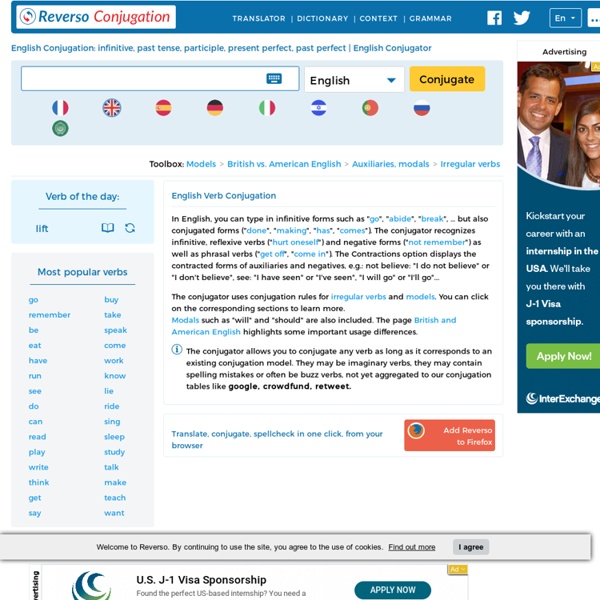



Present simple and present continuous Examples I play tennis every Sunday. I’m playing hockey now. She eats fruit every day. She’s eating an apple now. Remember! We use the present simple to talk about routines – what you do every day or every week. Be careful! For the present simple, add ‘s’ or ‘es’ for he/she/it. We say... I wake up every morning at 7:00.
Logos Conjugator English Dictionary online LEXILOGOS >> •Oxford (compact) English dictionary • Oxford (advanced learners) English dictionary & American English • Macmillan: English dictionary • Chambers: English dictionary • Collins: English dictionary • Cambridge (advanced learner's dictionary) • Longman: English dictionary • Merriam-Webster (American) meaning , etymology, pronunciation (+ audio) & thesaurus • Learner's dictionary • Visual dictionary by topics • American Dictionary of the English Language by Noah Webster, 1828 edition • The Century Dictionary (American, 1881) dictionary & encyclopedia: 500 000 meanings • Etymonline: etymological dictionary • Word info: etymology of English words derived from Latin and Greek words • Roget's Thesaurus: synonyms & broaders • Hyperdic: synonyms & broaders, meanings • Visuwords: synonyms (graphical dictionary) • Dictionary.com: American dictionaries: Random House, American Heritage... • Wordnik: American dictionaries: American Heritage, Century... & etymology, examples • rhyming dictionary
PsyBlog: Why We do Dumb or Irrational Things: 10 Brilliant Social Psychology Studies Ten of the most influential social psychology experiments explain why we sometimes do dumb or irrational things. “I have been primarily interested in how and why ordinary people do unusual things, things that seem alien to their natures.Why do good people sometimes act evil?Why do smart people sometimes do dumb or irrational things?” –Philip Zimbardo Like famous social psychologist Professor Philip Zimbardo (author of The Lucifer Effect: Understanding How Good People Turn Evil), I’m also obsessed with why we do dumb or irrational things. The answer quite often is because of other people — something social psychologists have comprehensively shown. Each of the 10 brilliant social psychology experiments below tells a unique, insightful story relevant to all our lives, every day. Click the link in each social psychology experiment to get the full description and explanation of each phenomenon. 1. The halo effect is a finding from a famous social psychology experiment. 2. 3. 4. 5. 6. 7. 8. 9. 10.
Grammar Auction: Turn grammar review into a game – tekhnologic This is not a new activity and you can find several descriptions of a grammar auction online. You may find these descriptions Grammar Auctions useful: Clare Lavery describes a Grammar Auction for teachingenglish.org.uk. Bjorn Norstrom describes a Grammar Auction for Dave’s ESL café’s idea cookbook. Alex Case suggests some variations on Grammar Auctions for TEFL.net. The other day, I was trying to find some inspiration because I was having a difficult time thinking of something to create for the website. Watch this video for an introduction to the template and instructions on how to edit it. After you have watched the video, continue reading to download the template and for a more detailed description about using it in the classroom. Watch the tutorial video to see how to edit and use the Grammar Auction template.Video run-time is 3 minutes and 26 seconds. Click on the image or the link below to download the template. Download the Grammar Auction template. Click on a ‘hammer’ button. “Wow!
Mission Europe Urban Dictionary, December 30: brickberry The 12 Kinds of Ads In 1978, Donald Gunn was a creative director for the advertising agency Leo Burnett. Though his position implied expertise, Gunn felt he was often just throwing darts—relying on inspiration and luck (instead of proven formulas) to make great ads. So, he decided to inject some analytical rigor into the process: He took a yearlong sabbatical, studied the best TV ads he could find, and looked for elemental patterns. After much research, Gunn determined that nearly all good ads fall into one of 12 categories—or "master formats," in his words. At last year's Clio Awards, I saw Gunn give a lecture about these formats (using ads mostly from the '70s and '80s as examples), and I was fascinated by his theory. I soon found myself categorizing every ad I saw on TV. This slide show presents some recent ads exemplifying each of Gunn's 12 basic categories. Click here for a slide show on Gunn's 12 master formats.
Timelines The language used by teachers to explain time reference, particularly of verb forms, can be confusing for the students. Timelines are neat devices that can be used to clarify our teaching language. Timelines enable the communication of sophisticated concepts to the lowest level of learner, and can prompt sophisticated discussion amongst higher level learners. This article is a basic introduction to timelines. Later articles will discuss when to use timelines in class, concept checking, activities and strategies that use timelines and their potential drawbacks. What is a timeline? What is a timeline? Timelines are diagrams that illustrate the reference to time made by a given piece of language. Why use timelines? Timelines are used to: What does a timeline look like? The basics A horizontal line represents the basic line of time. This line is usually marked with a point that represents now. To emphasise the direction of time, the line may be capped with an arrowhead.
The Polyglot Dream | a unique way of learning languages